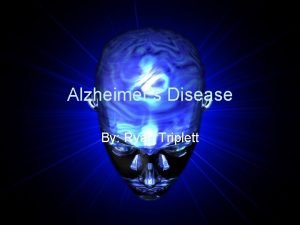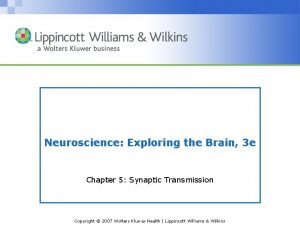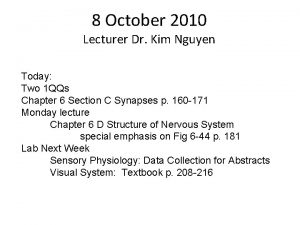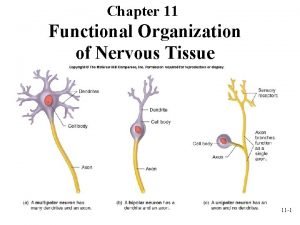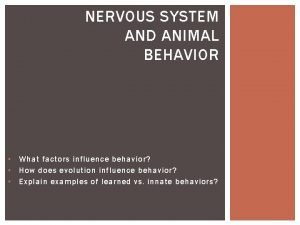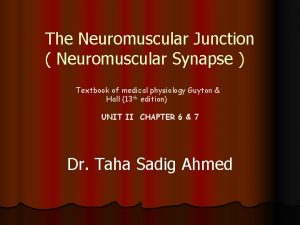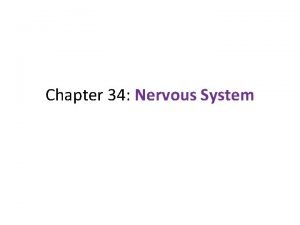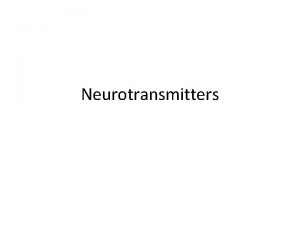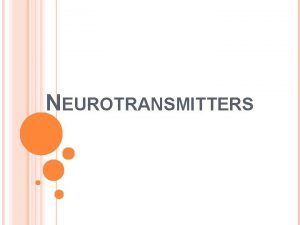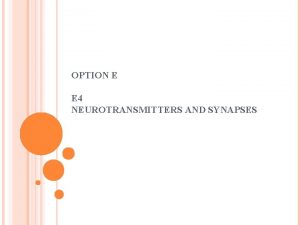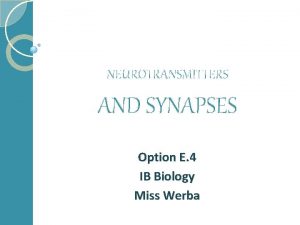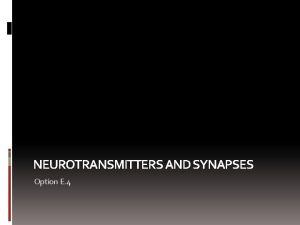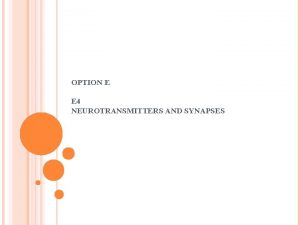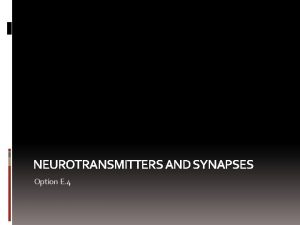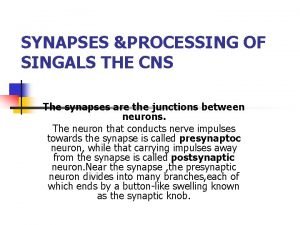Option E 4 Neurotransmitters Synapses Page 360 Synaptic












- Slides: 12

Option E. 4 Neurotransmitters & Synapses Page 360

Synaptic Transmission • Neurons communicate with each other chemically across a space called a synapse • Presynaptic membrane – Sending • Postsynaptic membrane – Receiving • The molecule moving across the space (synaptic cleft) is called a neurotransmitter

Neurotransmitters • Some NTs are excitatory – Stimulate the next neuron to forward the message – Increase the permeability to positive ions (positive ions move in) • Some NTs are inhibitory – They cause positive ions to move out of the postsynaptic cell – Movement of positive ions back into the synaptic cleft chemically depresses the postsynaptic cell (harder to excite)

Question • When two neurons communicate with each other, the presynaptic neuron sends a message across the synapse to the postsynaptic neuron. – 1. What type of molecule carries the message across the synapse and what type of molecule receives the message? – 2. Explain the two ways that presynaptic neurons can act on postsynaptic neurons.

Decisions, decisions • What interaction occurs between excitatory and inhibitory presynaptic neurons acting at the synapse? • Open your book to page 361. Read pages 361362. Then answer the following questions: – In your own words, outline the steps of decision making in the central nervous system. – Identify an excitatory neurotransmitter. Outline how an excitatory neurotransmitter works. – Identify an inhibitory neurotransmitter. Outline how an inhibitory neurotransmitter works.

Psychoactive drugs • Before we talk about how drugs affect the brain & personality, we need to have a fundamental understanding of two neurotransmitters: – Acetylcholine – Noradrenaline

Cholinergic vs. Adrenergic Synapses • Synapses using acetylcholine are called cholinergic synapses – Nicotine, for example, stimulates transmission in cholinergic synapses calming effect • “C” • Synapses using noradrenaline are called adrenergic synapses – Cocaine & amphetamines stimulate adrenergic synapses increased alertness, energy & euphoria • “A”

What’s amphetamine? • Adderall (ADHD/cognitive control) • Sometimes prescribed “off label” for depression, obesity & nasal congestion

Effect of drugs on the brain • Drugs can alter your mood & emotional state • Excitatory drugs like nicotine, cocaine and amphetamine increase nerve transmission • Inhibitory drugs like benzodiazepines, alcohol and tetrahydrocannabinol (THC) decrease likelihood of nerve transmission

How can drugs change synaptic transmission? Block a receptor for a neurotransmitter Block release of a neurotransmitter Enhance neurotransmission by mimicking a neurotransmitter • Block removal of a neurotransmitter from the synapse and prolong the effects of the NT • •

EXCITATORY!!!! DRUGS • Turn to page 365. • Explain the effects of nicotine, cocaine and amphetamine in terms of their actions at the synapses in the brain.

Inhibitory Drugs • Turn to page 366. • Explain the effects of GABA, alcohol and THC in terms of their actions at the synapses in the brain.


